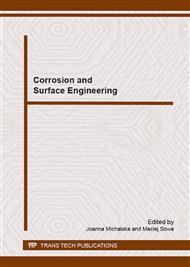p.401
p.405
p.409
p.413
p.417
p.421
p.425
p.431
p.435
Oxidation Resistance of Diffusion Silicide Coatings on Mo and TZM Alloy
Abstract:
Characterization of microstructure of pack cemented silicide coatings based on MoSi2 phase was described in this article as well as a short term oxidation resistance of these types of coatings at temperature 1200oC. Silicide coatings were deposited on top surface of Mo and Mo alloys of TZM type by diffusional process of siliconizing in activated powders. Morphology of coatings was characterized by evaluation of chemical and phase’s composition of deposited coatings by EDS and XRD methods respectively. In the case of Mo sheet after diffusion process of siliconizing single layer of MoSi2 type was obtained, but in the case of TZM alloy, in the same conditions of process, double layered coating was generated. Thick outer layer was build form MoSi2 phase, but very thin internal layer consist Mo5Si3 phase. The thicknesses of coatings were ca. 45μm, and were uniform. Morphology of coatings was free from inclusion and contaminations in their cores. The isolated cracks were observed, but their volume was very small. The oxidation test was performed at temperature 1200oC. The specimens were tested at 25, 500 and 100 hours of test. After each period of test characterization of coatings top surface was made. Total destruction of specimens was observed in range between 50 and 100 h of test.
Info:
Periodical:
Pages:
417-420
Citation:
Online since:
January 2015
Keywords:
Price:
Сopyright:
© 2015 Trans Tech Publications Ltd. All Rights Reserved
Share:
Citation:


